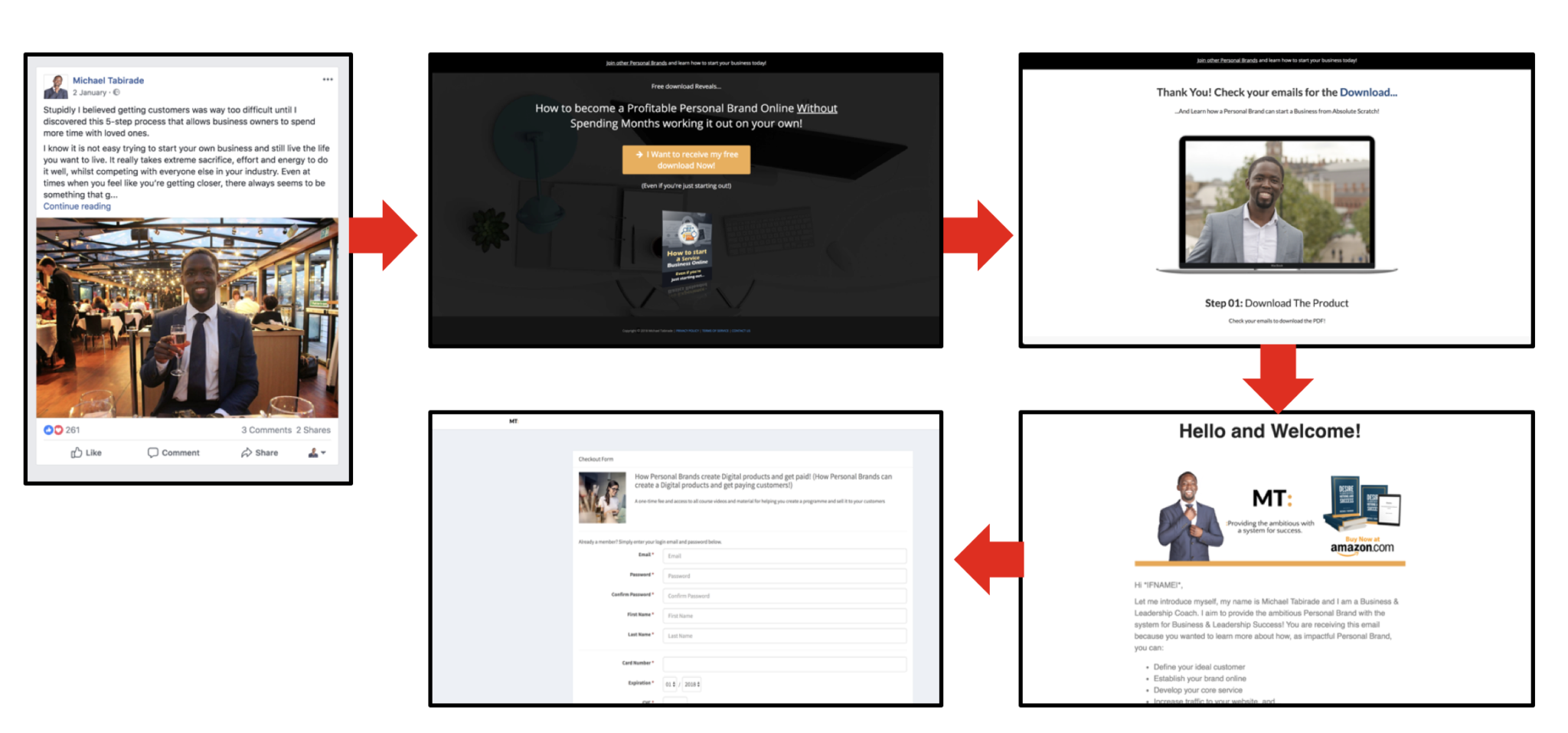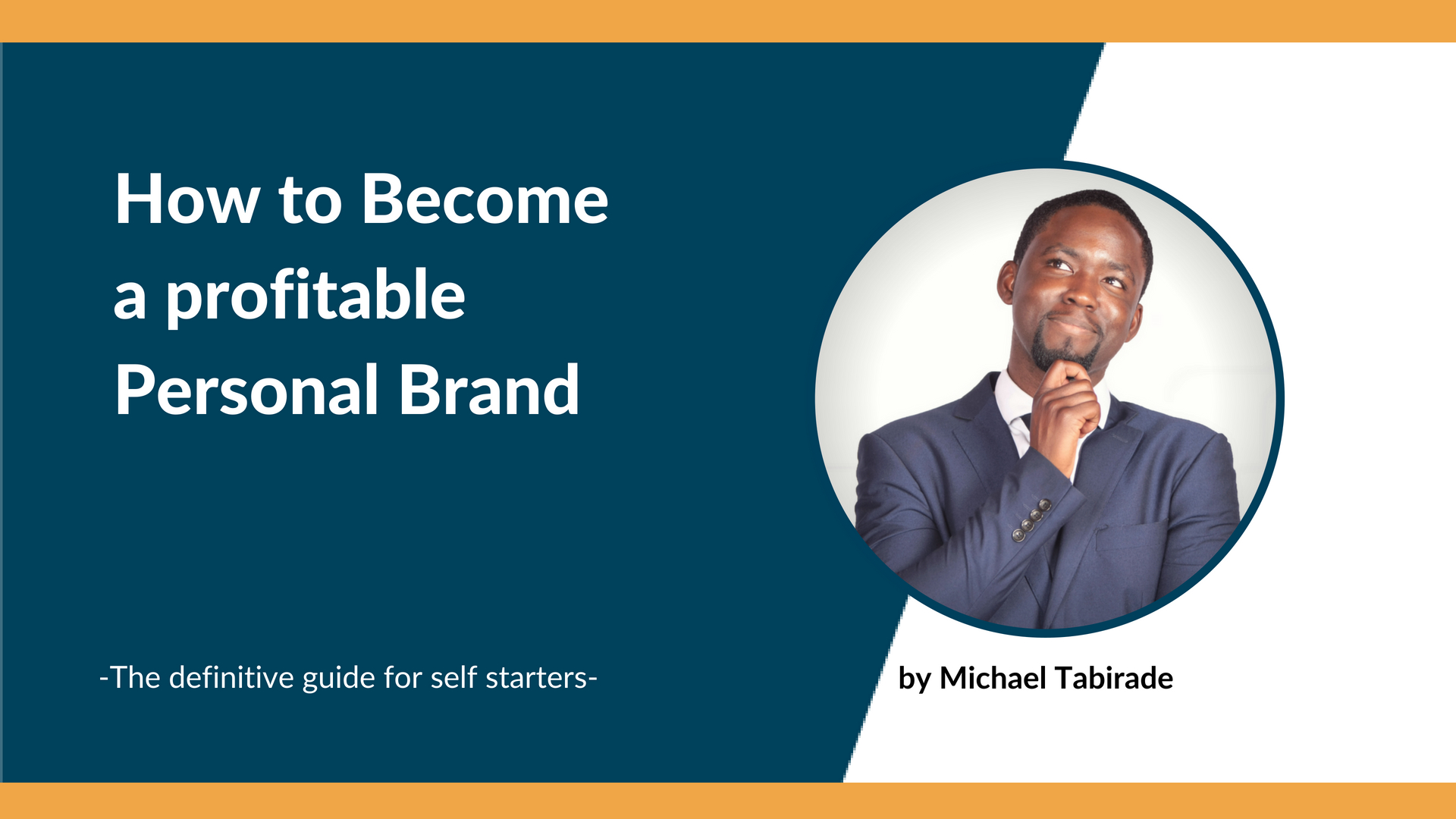How to Make Money Online as a Personal Brand
Everyone’s talking about the importance of a Personal Brand, right? We all know that a strong Personal Brand can bring us increased opportunities. But what almost no one talks about is how a Personal Brand can become profitable online. It’s not getting lot’s of Instagram followers, it’s producing an asset that provides high value. And that can happen even if you don’t know how to create one. In this article I will show you the exact steps to becoming a Profitable Online Personal Brand.
My goal for this article is to help two types of people. For those of you who are beginners, you’ll learn how to find and dominate a niche market, develop as a strong expert in your niche, and how not to take years building a business online. For more experienced people, you’ll get a blueprint behind how you can further refine your target audience, sharpen your skills as an expert and tighten up your funnels online.
I want you to remember the following:
The ONLY WAY to for you to get online success is to create a digital asset you can sell. The ONLY WAY to build a digital asset is through publishing online courses and become profitable as a Personal Brand.
Here is what we are going to cover:
- Identifying your credentials
- Creating a profitable Niche
- Defining your ideal customer
- Creating your Marketing message
- Building your online platform
- Advertising online
Identifying your credentials

Not many people like doing this part because they don’t know how to approach it or they cannot be bothered. It usually isn’t connected in our minds to business activity, and therefore it is invalid. There are some of you who are confident about knowing exactly what value to provide to a marketplace and other people, and there are some of you who nervously have no clue. Here are some things to consider when determining your credentials:
- Write down a list of your career and voluntary experiences, qualifications, certifications, interests, and hobbies accumulated over the past 10 to 20 years.
- Once you have done this in a table you can identify any patterns or themes of learning you have established over the years. Write down your themes and rank them out of 5 in order of how confident you are about that particular subject area, in addition to how much you like that subject area.
- You should now have a winner and feel confident that it is something you at least know a decent amount of information on, even if it requires a bit more education on your part.
- If you are still confused, ask at least 5-10 friends and family members what they think you are good at and what you talk about the most. This very simple exercise can help compare and contrast what reigns true for you and what doesn’t. You can also compare what has been said, to what you have written, helping you come to a conclusion.
Sometimes it can be hard to define what we are good at or how we provide value to others, however it is an important step because it will determine the tone for your business activity. If you do not know your value, your offer to your target audience will feel alien to you and to those seeing your offer. It is all about being congruent, and installing confident into your business.
Creating a Profitable Niche

Now that you know the value you provide, or at least are familiar with your credentials, you should have an idea as to what sort of industry you want to focus on. Now this can’t just be any industry, it needs to be one that has a track record of making money. Although we can’t always 100% verify this, there are a few indicators that help us. There are three major niches that are profitable, Health, Wealth and Relationships, where 60% of what is searched for online is health related. This doesn’t mean you have to do something health related, it is just something to note! Now, we can’t stop at this niche and start setting things up. We need to rather focus on breaking down those niches even further to find an opportunity. Here’s an example, let’s say I chose a niche in ‘Wealth’, I can break that down to ‘Online business’, and further break that down into ‘helping undergraduates start an online business’. Can you see what I did there? I choose a super niche, highlighted a sub-niche, and then added “helping + [Audience] + with [sub-niche]”. In order to find a sub-niche you can do the following:
- Type in niches in Wealth, Health or Relationships
- Find out the major problems and pains people are experiencing in these niches and pick a popular one you are either confident or interested in exploring. The platform I use to do this is quora.com. It is so under-utilised and it is a powerhouse of information. It is also useful because you can very quickly see the pains and desires of your audience, which will be useful for putting together your marketing message.
- Check out major sites that have search engine capabilities like Google, Amazon, Udemy, Clickbank and YouTube to verify popularity of certain sub-niches. You can compare how many results are returned between niches to get an idea of demand. In addition, it would be good to type in the sub-niche keyword and add “course,” “event,” “blog” and “book” to see what the market looks like. This will reveal the leaders of that industry, what they are doing and what people are looking for. You may want to record your themes in a separate table or working document once you have chosen a sub-niche. Also be sure the short and long-tail keywords you use to search for specific topics online, as these may be useful for future marketing copy.
In terms of finding your audience this does not have to be too burdensome. The main thing to bare in mind are the following:
- Choose an audience that you are familiar with or can identify with. Example if you are a middle-class working mother, and you have an interest in solving a big problem that other mothers can relate to, may be that is your audience
- When reading on the internet and doing research in your industry, try to identify any gaps for people who are being underserved. An audience is defined via
- Age
- Demographics
- Work
- Industry
- Location
- Interests
- Beliefs
- Behaviours
Once you have done all of this, simply put your work into one simple line:
“I help university graduates in London start their own affiliate marketing business”
Defining your ideal Customer

The next step is to define your ideal customer. Now historically many people have said that you should simply do an avatar and write down their demographic and psychographic information, as well as their consumerist behaviour. I’m telling you that is not enough! You need to immerse yourself deeply in the minds of your audience, and speak a language they understand. I suggest doing the following.
- Ask a minimum of 50 people, friends, family, colleagues, acquaintances, mentees, clients, social media friends, email contacts and anyone else in your “circle” what is the biggest thing they would want to learn and why? So for example you may say the following: “Hey Frank, if you were starting your own business online what one thing would you want to learn and why?” Now if they give you a whole bunch of answers get them to prioritise them. Don’t forget to record what they say! You can do this face-to-face, via instant or text message, or anything else, just make sure you record their response.
- Once you have done this collate all your answers, put them into major themes (anywhere between 6 – 10) and prioritise them in order of popularity. Not only do you have a potential course outline but you are capturing the audience’s core pains! I would advise if you haven’t done so already, the best thing to do at this stage is to:
- Read 2 – 5 books on that focus on solving this core themes generated by your audience
- Read articles on these topics
- Attend at least 2 events that teach these topics and allow you to meet people within the industry
- Become a practitioner and solve these problems for yourself, or practice solving them for other people via informal/formal coaching
*Please note that steps a-d are for people who are not confident or versed in these fields and want to feel like an expert. This can typically be done anywhere between 30 – 90 days if you focused!
Now for marketing purposes you want to make sure you have the right “ideal customer” in mind. For quality purposes you need to review the research you did earlier to determine your niche and answer the following questions:
- What does your audience normally see?
- What does your audience normally be, do or have?
- What does your audience normally say?
- What does your audience normally hear?
- What does your audience normally think?
- What are your audiences deepest pains?
- What are your audiences deepest desires?
- What are your audiences basic demographic information?
When you answer these questions honestly, based on primary and secondary research, you will have a very good understanding of your customer. A lot of your marketing will be focused on the ideal customer’s pains and desires, and using keywords that relate to the experiences they have in their everyday life. By choosing the main pains and gains you can advertise to your audience using Facebook Ads with this structure in mind. An example headline for your marketing could be “How to Create £10,000 in 180 days, without breaking your back learning how to do it!” The key things to remember here is the How to… (i.e. highlighting their desire) and without… (i.e. highlighting their pain).
Can you see that answering these questions properly will get you into the mindset of your target audience. Now when I say “properly” it doesn’t mean take forever, it means back it up by the research you have done before, and use your own intelligence to answer them appropriately. You can do this how you want, as long as you can refer to this regularly to remind you of what your ideal audience is about.
When defining their deepest desires, think about why they want what they want, and dig down to their deepest why. Ask “why” to yourself at least 5 times to see what their deepest desires are until it makes sense; usually it is attached to an experience linked to security, freedom, or a feeling. In essence you will use this information to write marketing material that will focus on the problem that your ideal target audience is experiencing, introduce a story that highlights this same issue, define how you overcame this issue yourself, explain how they can overcome it, and how they can start doing so with some free information.
Creating your Core Marketing Message

In order to do this well you need to pick a core pain or desire that your ideal audience relates to and create an Ad around this. This should be easy as you had found out this information in your prior research, as well as when you ask your 50 – 100 people.
Choose the core pain and core desire you think relates to your audience, and begin writing your marketing message. In the example before we already established what you do i.e.
“I help university graduates in London start their own affiliate marketing business”
Using this to help you create your marketing message you should always add how you do this. At the beginning, we established that the ONLY WAY to be successful online was via selling online courses, so here we will add:
“I help university graduates in London start their own affiliate marketing business using the power of online courses”
You can always add adjectives to this description, however the simpler you make it the better. It pays to memorise this as it will not only help you online, it will also help you when you meet people.
You will then need to craft a marketing message that will probably be seen by others using Facebook Ads. You want to follow the following structure
- Headline identifies your ideal audience, highlighting their pain and/or desire
- Your story and how it relates to them now
- How you overcame your situation
- What was the solution
- How they can overcome their struggle
- How they can find out more to solve an immediate pain
Point six is where you create a subtle but firm call to action (CTA) that leads then onto free and valuable information in exchange for an email address. This information can be in the form of a blog post, video, mp3, PDF download etc. This free information will explain what the person should do to overcome their core problem, but will not necessarily focus on the full how. The more comprehensively this free information helps to solve an immediate issue, the better! Please remember it is important to be GDPR compliant at all times and no one should be forced into being on your email list! Search online for GDPR regulations for more information!
Building your Online Platform

You have defined your value, done your market research, established your ideal customer and put together your core marketing message, now it is time to create your online platforms to express your marketing funnel. To explain, a funnel is the journey your prospect experiences from start to finish. It is how your customer begins to “Know, Like and Trust you” throughout the funnel journey. You would be exposing them to material that will be of benefit to them along this funnel. For now, I want you to understand this very simple funnel, and it goes like this:
Video Facebook Ad → Free Report on Lead Capture Page → Thank you Message with additional Instructions → A series of emails sent to the prospect over 10-14 days → An offer is made in the final email.

Your mission is to build a soundproof funnel that will get results. The best advice is to start building one and test each part of it on the way. The best way to start is to look at your market research and see what those in your industry are already doing and understand their funnel, their marketing message and their offer, and see how easy it is to replicate. Start liking particular facebook pages that are in your industry and save Facebook Ads that are doing something similar to what you want to do. Although this article is a comprehensive guide on how you can start online, this will not be able to cover absolutely everything, however here are some crucial things you should know:
- Facebook Ads are not scary. Make sure you have a clear and engaging image you can use, or a video that connects with your audience through stories. Facebook has a full library of images you can use as you setup your Ad. Your Video Ad should be no more than 6 minutes long. It can be a training, information piece or a break down on your challenges and success in life (exactly what you produced in your core marketing message). With Facebook Ads you’re testing to see what interests work well. Use your market research to test what interests work well and split-test them one at a time. All you need is £5 or $5 a day over a week to see what works per Ad. In addition, when running your Ads it is important to track all information using Facebook pixels installed on your lead capture and thank you pages. The aim is to stick with the winning Ads based on the data you receive. If you want to join free web-class on how to master Facebook Ads click here
- Your report can be created on Microsoft word very easily! And if you need graphics you can always use the free service canva.com to create awesome graphics! Your report should be long enough to be interesting. Introduce yourself, explain the importance of this information, and teach them something new! The lead capture page can be created using WordPress or OptimizePress, however many pros use the likes of Leadpages, Kyvio or ClickFunnels. The optin box used to capture the emails on submission will be integrated to your autoresponder such as MailChimp or Aweber in order to trigger the automated emails you’re sending to your growing list
- The Thank you page will also be created using the platforms suggested before, and will include “Next Steps” for your prospects to follow
- The automated emails you develop for those who have subscribed to receive the free content should get an email immediately, including that content. Regardless of what autoresponder you use (the platform used to send out and manage email communications to subscribed individuals on mass), the first email should be a welcome email explaining what your brand is about and what they can expect. The next couple of emails you send out should introduce yourself and how you got to where you are now, then teach them something of value, teach them something of value again, and do it again, and finally end with making an offer to them that they cannot resist. The aim here is to try and engage with them throughout each email, maybe via a group, or commenting on a post, as well as getting them excited about the next email. Whatever it is, you want their genuine by-in before you make an offer. This offer needs to have an element of genuine scarcity in it to encourage people to buy. Genuine scarcity could be a set amount of time to purchase a product before it expires or doubles in price, the offer could be at a reduced price for a specific number of people.
As you can see this section is comprehensive, and the best thing to do is re-read this again, understand why you do what you need to do, and then attempt to build your wealth machine!
Advertise Online

Even though this is heavily linked to the last point, I want to emphasise that if you master advertising, with great copy, great branding, and with a great marketing core message, your prospects will turn into customers, and your customers into an enthusiastic and paying community! Advertising does not just come down to Facebook Ads, it is also about how you carry yourself as a brand online, via your social media, website and general online presence. Although you do not need all of these things to start an online business, the majority of you will have some sort of online presence. Key things to remember:
- Don’t commit to posting articles and social media posts daily, unless you know you are going to commit to posting! Usually, this involves having a content calendar of some kind and an automated system to help you do this
- Talk to your community as if you are their best friend, and do not get caught up in drama online
- Keep your brand consistent i.e. your colours, your message, your pictures etc.
As a Personal Brand, people are buying into you, and you are your biggest advertisement.
For paid ads, I generally advice using Facebook. Now I am biased because I prefer using Facebook due to it’s incredible precision and targeting functionality, however you should use what works for your audience. It is very unlikely that there is not an audience on Facebook and Instagram. If you want to find out more about how you can use Facebook Ads better you can join this web-class here
Summary
Here’s a recap on the 6 core elements for online success as a Personal Brand:
- Identifying your credentials
- Creating a profitable Niche
- Defining your ideal customer
- Creating your Marketing message
- Building your online platform
- Advertising online








One Comment
Comments are closed.